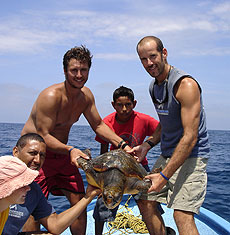UCSC Current: Grad student works to save sea turtles
- wallacejnichols
- Jan. 3, 2006
By Tim Stephens
The critically endangered North Pacific loggerhead turtle nests only on certain beaches in Japan, where the number of females showing up each year to lay their eggs has dropped below 1,000. These long-lived sea turtles travel widely in the Pacific Ocean, and Hoyt Peckham, a graduate student in ecology and evolutionary biology, has been studying them in southern Baja California, where they congregate to feed.
 Graduate student Hoyt Peckham, right, and fellow researchers prepare to release a young loggerhead turtle in Baja California. Through Project Loggerhead, Peckham is working directly with local fishermen and their families in Baja California to study turtle populations and develop strategies to keep turtles from dying in fishing nets. Photo above by Johath Laudino Santillán; photo below by Victor de la Toba
|
His research addresses important questions about the migrations, habitat use, and life history of these remarkable animals, and the results are helping to guide conservation efforts.
Peckham knows that research alone will not save the turtles, so he has helped develop a community outreach and education project that fosters ocean conservation in small fishing villages along the Baja California peninsula.
"Our long-term vision is to empower the fishermen and others living close to marine ecosystems to understand and manage their shared marine resources," Peckham said.
Peckham came to UCSC with extensive experience in marine conservation--he cofounded the nonprofit Center for Cetacean Research and Conservation and worked on a wide range of conservation and public education projects. But he wanted to augment that experience with the rigorous quantitative research skills and theoretical perspective that a Ph.D. program could provide. Peckham's advisers in the Department of Ecology and Evolutionary Biology are Adjunct Professor James Estes and Associate Professor Donald Croll. He has found that the academic community and interdisciplinary atmosphere at UCSC suits his interests even better than he had expected.
"UCSC has worked out unimaginably well for me," he said. "The Department of Ecology and Evolutionary Biology is giving me the tools to assess the sea turtle populations and the research techniques to study their behavior and habitat use. I've also found great support for our outreach work from faculty in education, psychology, and environmental studies."
Loggerhead turtles are slow to mature, spending their first 40 years as juveniles roaming throughout the North Pacific Ocean. They die by the thousands as incidental "bycatch," tangled in fishing nets and caught on longlines set out to catch fish. Peckham and his local partners have found that the impact on sea turtle populations from small-scale fishing, like that of the fishermen he works with in Baja, rivals the effects of large-scale commercial fishing operations.
An encounter with a local halibut fisher in Baja in 2002 impressed on Peckham the gravity of the problem. "How can loggerhead turtles possibly be endangered?" the man asked. "I caught 30 in my nets this morning."
Since then, Peckham and his research team of local student interns have interviewed dozens of fishermen, observed hundreds of fishing trips, and surveyed thousands of miles of beaches to quantify the bycatch problem. "Our findings are staggering," he said. "We estimate that thousands of loggerheads are killed each year as bycatch just along a very narrow bit of the Baja California Sur coast."
Although they forage throughout the North Pacific, a large proportion of the loggerhead turtle population gathers off the Baja California peninsula. They go there to feed on small crustaceans called pelagic red crabs, which are so numerous at times that they turn the water red.
To local fishermen in Baja California, loggerhead turtles seem to be abundant and thriving. But this is an illusion, Peckham said. Surveys of the nesting beaches in Japan have shown declines in nesting activity of 50 to 90 percent since 1990. Because it takes at least 30 years for a loggerhead turtle to reach reproductive maturity, there are far more juveniles in the population than adults.
Peckham said the local fishers are almost always receptive to the idea of protecting the turtles once they understand their important role in the turtles' future. Although his research has shown that their fishery may be the biggest single cause of loggerhead turtle deaths in the Pacific, he is quick to defend them.
"There's no reason to castigate these guys," Peckham said. "For a number of good reasons, they haven't realized the impact they're having, and they haven't seen any reason to look for alternatives."
Peckham is partnering directly with local fishermen to develop alternatives to current fishing practices and to spread the word about reducing sea turtle bycatch throughout Baja California fishing communities. Wallace J. Nichols, a biologist at the California Academy of Sciences who pioneered sea turtle research and conservation in Baja, has been instrumental in these efforts. Working with Nichols through Pro Peninsula, a binational nonprofit focused on the Baja California peninsula, Peckham codirects Proyecto Caguama (Project Loggerhead).
Read more here
